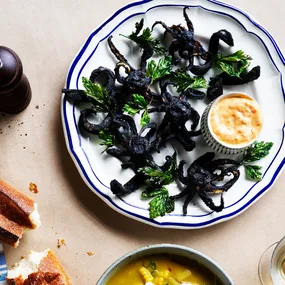There’s nothing more comforting in winter than a straight-from-the-oven braised meal (aside, perhaps, from that lovely glass of red you’ll pour yourself while your oven does all the hard work).
For great success when braising, it’s important to invest in a heavy-duty casserole with a tight-fitting lid. It’ll give you good heat control and the ability to lock in the all-important moisture, as well as withstand the inevitable wear and tear. (Le Creuset is a favourite in the GT offices.)
Although the flavours in braises can vary, the components remain the same, and once you’ve mastered one, a world of simple casserole-cooked dinners awaits. You need a combination of dry gentle heat, slow cooking time and moisture to braise. The liquid, usually a stock (be sure to use a good quality one; for recipes and tips, click here), keeps the meat moist, while a low, stable temperature over a long period allows the meat’s connective tissue to break down and flavours to come together.
Working muscles or secondary cuts of meat and meat on the bone are well suited to this technique because they need long and slow cooking to become tender, and the liquid helps with this too. Meat cut into smaller portions requires a cooking time of anywhere from one to three hours in a moderate oven before it becomes melt-in-the-mouth tender. A larger piece – like the ol’ fashioned chuck used here – will take around four to five hours, if not more. Other cuts to consider include osso bucco, lamb neck, beef blade, beef cheeks and lamb shoulder, to name a few.
The meat can be browned in some fat first to add colour and extra flavour from the caramelisation that will occur on the meat and the base of the pan. Alternatively, you can skip the browning process – a traditional daube of beef, for instance, is marinated overnight in a mixture of wine, vinegar, herbs and spices to add complexity to the dish, then simply thrown in the pot with everything else and cooked over a long period (six-ish hours) until meat and flavours bind together.
If you’ve browned your meat, deglaze the pan with wine and sometimes a splash of vinegar, scraping the pan to lift the remnants; they carry so much flavour. And remember, use a good quality wine, one that’s good enough to drink. Add herbs and vegetables to boost the flavour further – vegetables can be chopped or kept in larger pieces and served as we’ve done here.
Now we come to the cooking liquid. White wine and chicken or veal stock produce a lighter sauce, whereas red wine and beef stock give you a heartier dish. Beer, cider, passata or even milk (like the Italian pork braised in milk, sage and lemon zest – maiale al latte) can be used. The liquid need only cover the meat by half or three-quarters, so turning the meat during cooking is a good idea. But if you like, you can cover the meat completely with liquid and then reduce it at the end for a concentrated sauce.
The last step is to degrease the dish. This can be done by chilling the braise overnight in the refrigerator – the fat solidifies and rises to the surface, making it easier to extract, and besides, this kind of cooking always tastes better the next day. Otherwise, just spoon the fat off the top as you go and blot the braise with some absorbent paper when it’s finished cooking, just leaving a little bit for flavour.










